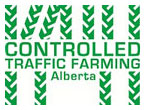Agronomist Notes
Finally, a decent week of weather! I’d say the majority of my clients are 20% done with most of their wheat acres in. We’ve started to seed canola, even if it meant switching out of wheat, as I’d prefer to have canola in the ground before May 7 to avoid flowering in the summer heat. Yield penalties from late seeding canola are far worse than late seeding wheat.
Except for the wetter low lying areas, overall seedbed conditions are excellent. In my travels from Drumheller to Calgary and up to Three Hills, I’ve seen and heard of fields that are quite dry because they were anhydroused or cultivated last fall. Fields that were cultivated to smooth out ruts caused earlier in the season are very dry in the top four inches.
I’ve had many questions about pre-burn timing, when to heat up your straight glyphosate to control tough weeds and options for controlling volunteer RR canola. In this week’s newsletter, we’ll take a look at those questions and provide a few options for control.
Agronomy
Pre-Burn Timing: Rules of Thumb
The cool weather this spring has many producers wondering when to begin spraying in the mornings or when to shut down at night. Below are some rules of thumb to help you with those decisions. To maximize the efficacy of your pre-burn herbicide follow these guidelines:
Daytime Temperature: Apply a pre-burn herbicide when temperatures reach above 10oC for a minimum of 2 hours before application to improve results and increase the speed of control. Discontinue application when temperatures approach 10oC towards the evening.
Nighttime Temperature: Temperatures below -4oC the night prior to a pre-seed burn down cause foliar damage to weeds and reduced herbicide translocation. Typically, applications may resume when active weed growth is observed or usually within in 24 to 48 hours of warmer temperatures that support weed growth.
Seeding or Tillage: Seeding, tillage or banding operations may occur within 3 to 6 hours after application under normal conditions. If perennial weeds such as dandelion are present, a minimum 3 day delay prior to any field work is required following an application of glyphosate.
Source: Dow AgroSciences
When is Straight Glyphosate Not Enough?
The weeds listed below are tough to kill using straight glyphosate. The addition of a broadleaf tank mix partner like Pre-Pass (florasulam), Express SG and 2,4-D may be necessary.
TIP: Upgrading your glyphosate may cost you an extra $3.00 an acre in pre-burn costs but in most cases if left uncontrolled it will cost you $3.00 acre in-crop anyway and you’ve lost yield potential and moisture.
Volunteer canola (especially RR)
Wild buckwheat
Kochia
Dandelions
Narrow-leaved hawk’s-beard
Toadflax
Winter annual weeds (cleavers, stinkweed)
Product information
Pre-Pass: http://www.agric.gov.ab.ca/app23/getproductinfo?id=601&view=dressed
Glyphosate + Express SG: http://www.agric.gov.ab.ca/app23/getproductinfo?id=1024&view=dressed
Glyphosate + 2,4-D: http://www.agric.gov.ab.ca/app23/getproductinfo?id=1181&view=dressed
Options for Pre-Seed Control of Volunteer RR Canola
Vounteer RR canola is one of those sleeping giants that go un-noticed until you finish seeding and see that your wheat field is a mat of volunteer canola. In a potentially dry year, controlling volunteer canola before it becomes a problem is absolutely critical.
I’ve listed a number of tank mix combinations to provide you with some options. All glyphosate recommendations given below are equivalent to RoundUp Original rates of 500 or 750 ml/acre. Please adjust rates to account for glyphosate containing higher concentrations.
RoundUp + 2,4-D amine or LV Ester 600
Rate: 500-750ml/ac + 240-360ml/ac
Registered Pre-Seed: Winter Wheat, Wheat, Barley, Rye
Stage: 1 to 4 leaf
RoundUp + 2,4-D amine or LV Ester 600
Rate: 500-750ml/ac + 480-600ml/ac
Registered Pre-Seed: Winter Wheat, Wheat, Barley, Rye
Stage: 4 to 6 leaf
RoundUp + MCPA amine or Ester 500
Rate: 500ml-750ml/ac + 200-280ml/ac
Registered Pre-Seed: Wheat, Barley, Rye, Oats, Flax and (Field Peas MCPA amine only)
Stage: 1 to 4 leaf
RoundUp + MCPA amine or Ester 500
Rate: 500ml-750ml/ac + 200-400ml/ac
Registered Pre-Seed: Wheat, Barley, Rye, Oats and Flax
Stage: 1 to 4 leaf
RoundUp + Buctril M
Rate: 500-750ml/ac + 200-400ml/ac
Registered Pre-Seed: Wheat, Barley, Rye, Oats, Flax, Canary Seed, Seedling Grasses
Stage: 1 to 4 leaf
RoundUp + Express SG
Rate: 500-750ml/ac + 6g/ac
Registered Pre-Burn: Wheat, Barley, Oats, Field Peas, Fababeans, Lupins and Canary Seed
Stage: 1 to 4 leaf
Pre-Pass
Rate: PrePass A 40ml/ac + PrePass B 500ml/ac
Registered Pre-Seed: Wheat, Barley and Oats
Stage: 1 to 4 leaf
CleanStart
Rate: Aim 15ml/ac + Credit 500ml/ac
Registered Pre-Burn: Canola, Cereals, Chickpeas, Dry Beans, Flax, Lentils, Field Peas, Sunflower, Mustard
Stage: 1 to 4 leaf
Focus on Consistent Seeding Depth: Dividends Paid in Yield and Maturity
One of the reasons we see a movement towards the John Deere 1870, Morris Contour, SeedMaster and Seedhawk-style drills is the benefit of even seed placement. Even seed placement translates into higher yields and even maturity when compared to opener styles and air seeders that leave you with 1 to 4 inches of seed depth variability.
Though you may not have a precision drill, paying attention to the details can pay dividends. Dr. Yantai Gan with Agricuture Canada at Swift Current says crops seeded unevenly are the worst. Shallow seeded plants emerge several days faster and compete with the slower emerging, deep seeded plants for water, light and soil nutrients, reducing their yield by up to 50% or more. There can be 10 days between the first and last plants to emerge, which can be crucial in a frost year.
Dr. Gan says frost or no frost, crops seeded shallow and uniform have a definite edge. They emerge more quickly and evenly, mature faster, and have higher yields. He led a three-year study that showed canola, mustard, and flax planted uniformly at ¾ of an inch in early May emerged 3 to 5 days faster than seeds planted at 2 inches and had yields up to 25 % higher. With lentils, the yield increased up to 15% at ¾ of an inch. Peas and chick peas only yielded 4% more due to their seed size and vigour at deeper depths. A small plot study with wheat showed a 27% increase in yield at 1 inch compared to 2 inches. “Small seeds like canola should never go deeper than an inch, no matter how dry it is. They exhaust energy pushing through deeper soil and it weakens the plant,” he stresses.
And it’s important to remember the deeper you seed in the spring, the colder it stays, says Dr. Guy Lafond, an Agriculture Canada research scientist at the Indian Head Research Station. Research trials have shown crops emerge up to 17 days faster with a soil temperature increase from 5 to 15 degrees Celsius, says Dr. Lafond.
Source: http://www.reducedtillage.ca/article.aspx?a=228
Market News
Commodity Index Funds Activity
|
Contracts |
Last Week |
This Week |
Position |
Change |
|
Wheat |
2,243 |
7,466 |
Net Short |
233% |
|
Corn |
188,851 |
160,915 |
Net Long |
-15% |
|
Soybeans |
75,796 |
78,561 |
Net Long |
4% |
|
SoyOil |
9,923 |
15,367 |
Net Long |
55% |
|
SoyMeal |
29,348 |
31,177 |
Net Long |
6% |
European Wheat Crop Looks Good
Despite the recent rain, crops in the EU generally appear to have every chance of achieving average or trend yields. According to weather sources, heavy rains will continue in 2008 and hamper grain production once again. In continental Europe, Eastern Europe and the Ukraine crops also look like achieving much better results than a year ago.
Source: www.Gleadell.co.uk
World Wheat Price to remain Firm
The weather window for potential damage to be caused to the world wheat crop is still there but it is narrowing. No-one expects prices to collapse this season even if we get a good crop worldwide - although they are already $50 a tonne off the top. But a further retracement of 40 to 60 dollars per tonne could certainly be on the cards unless the weather intervenes.
Source: www.Gleadell.co.uk
Dry Weather Continues in Australia
I’ve chatted with a few grain producers from Eastern, Western and Southern Australia this past week. The Eastern wheat and canola belt of Australia continues to be dry as well as South Australia. The wheat belt in Western Australia has had some spotty showers throughout the state but still remains fairly dry. Australia is just starting to plant wheat and canola now and their harvest begins in December. We have a long way to go before harvest, but none the less the season is starting off dry. SL
Satellite Imagery: http://weather.landmark.com.au/synoptic/
Struggling US Beef Industry Undergoing the Perfect Storm
US feedlots losing $170 per head is mistakenly blamed on ethanol. But while significant, it is only one of the strong winds that are battering the US beef industry. The sub-prime mortgage crisis, bio-diesel, over supply of pork, high fuel costs and excess processing capacity all combine into a perfect storm of a magnitude never seen before.
To set the stage it is important to understand the US beef industry’s total reliance on feedlots to finish cattle. Corn makes up 80% of that feed, so any adjustment in the price of corn directly affects the US beef industry. One of the key drivers of corn prices is the price of soybeans which compete directly in the US for plantable acres.
Soybean prices are at unprecedented highs partly due to the increased demand for biodiesel in Europe. Corn always runs at a price ratio of 2.5:1 with soybeans. If corn doesn’t, then simply put, American farmer’s plant more soybeans than corn. The world needs corn as it is a staple food. Subsequently, corn prices are also at unprecedented highs. Couple this with a third of this year’s US corn production going towards ethanol production, where does the poor old feedlot fit?
Well, they fit by losing money hand over fist. Year to date feed lots are losing $170 per animal and in some cases nearly $300 head. Basically they hadn’t anticipated rising feed costs and paid too much for the calves. Some say that this will change as feedlots restock with weaned calves at a lower purchase price. Most of these weaned calves will come available over the coming northern hemisphere summer and fall.
Source: James Parsons, New Zealand, Nuffield Scholar
Global Wheat Production Outlook
With most of the world’s major wheat exporting and consuming countries announcing 3-7% higher wheat seeding levels for the 2008/09 crop year, which begins this summer, a significant rebound in world wheat output is expected to 651 mmt, up 45 mmt from last year. Much improved prospects are expected in the EU (up 15%) and FSU (up 8%). Argentina’s recently harvested crop is projected 1 mmt larger than a year ago. Stats Canada announced that 2008 wheat seedings could jump 16% to over 25 million hectares on recent intentions. Australia also remains quite optimistic its output will jump 10-11 mmt over this year’s drought-impacted crop because La Nina in the Pacific Ocean is expected to wane this summer.
However, this year’s world consumption also will increase sharply as feed utilization and domestic demand recover dramatically after being severely curtailed last year. Overall, 2008/09 world ending stocks will likely rebound to 129 mmt from this year’s 112.5 mmt level, but wheat’s world supply tightness won’t decline much with the USDA’s stock/use ratio only increasing 2 points to 20.3%. Using US and world crop prospects, the USDA’s first 2008/09 world ending stocks level will be 454 million bushels, up about 200 million from this year. These will be adequate supplies unless one of the world export competitors has a crop problem, as occurred last year, so keep abreast of this year’s global crop situation.
Source: WWW.NARMSinc.com





